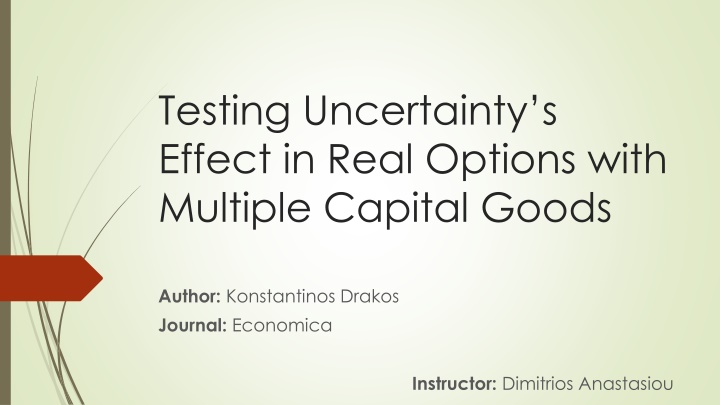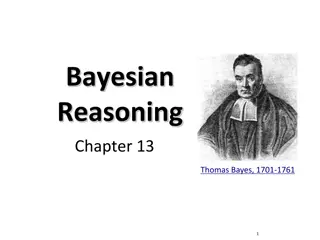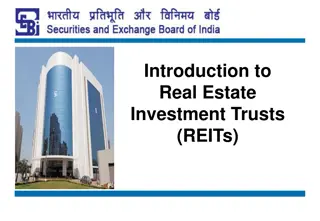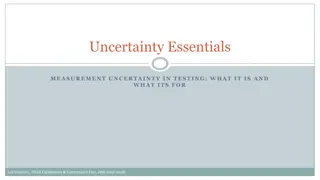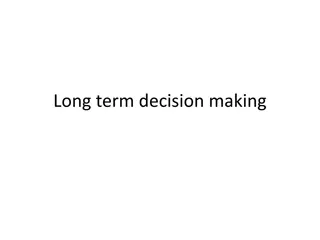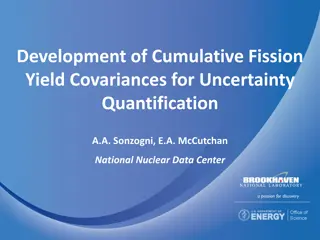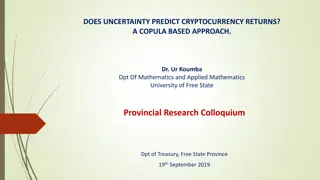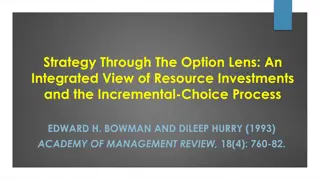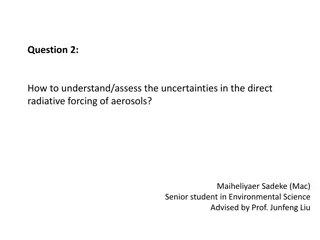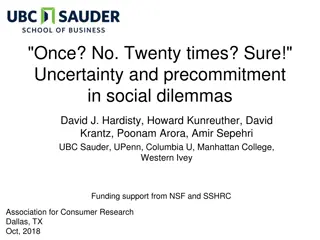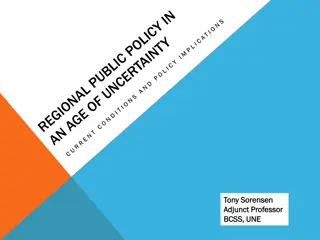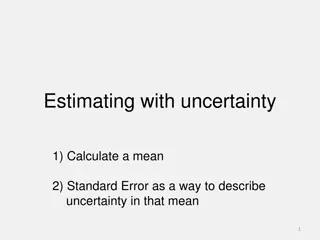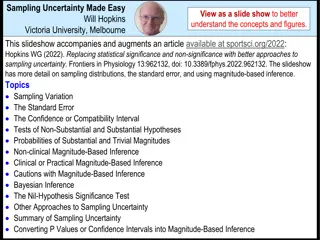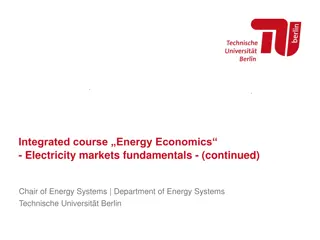Analyzing Uncertainty's Impact on Investment Decisions in Real Options Framework
This study by Konstantinos Drakos explores the relationship between uncertainty and investment decisions in a real options framework using plant-level data from Greece. It reveals a negative correlation between uncertainty and the investment extensive margin, suggesting a wait-and-see strategy in ambiguous environments. The analysis is based on data from the Annual Industrial Survey, covering 13 years and 21 manufacturing industries.
Download Presentation

Please find below an Image/Link to download the presentation.
The content on the website is provided AS IS for your information and personal use only. It may not be sold, licensed, or shared on other websites without obtaining consent from the author.If you encounter any issues during the download, it is possible that the publisher has removed the file from their server.
You are allowed to download the files provided on this website for personal or commercial use, subject to the condition that they are used lawfully. All files are the property of their respective owners.
The content on the website is provided AS IS for your information and personal use only. It may not be sold, licensed, or shared on other websites without obtaining consent from the author.
E N D
Presentation Transcript
Testing Uncertaintys Effect in Real Options with Multiple Capital Goods Author: Konstantinos Drakos Journal: Economica Instructor: Dimitrios Anastasiou
Introduction Previous theoretical literature has established that irreversibility of capital creates an embedded call option in investment decisions that leads to a modification of the standard net present value (NPV) rule or the q-theory (McDonald and Siegel 1986; Pindyck 1988; Dixit and Pindyck 1994). In particular, in ambivalent environments, investment is triggered at a higher threshold compared to the simple NPV case. Hence decision-makers may find inactivity as being optimal in certain situations until uncertainty is partly resolved (more information is revealed), known as a wait-and-see strategy.
Contribution - The gist of the paper Drakos (2011) found a clear negative relationship between uncertainty and the investment extensive margin using plant-level data for investment across multiple fixed assets and by employing a discrete ordered choice model as econometric methodology.
Data Issues (1) The analysis is based on plant-level data from the Annual Industrial Survey (AIS) for Greece, provided by the National Statistical Service of Greece. The dataset corresponds to 13 AISs spanning the period 1993 to 2005, and includes 6119 plants belonging to employees, across 21 manufacturing industries, giving a total sample of 57,531 observations. firms with more than 10 In Table 1, the distribution of plants by employment level is given across time.
Definitions and construction of variables (1) Extensive margin The AIS provides (gross) values for acquisitions (AQ) and disposals (DIS) by plant for the following five fixed asset types: (i) Buildings, (ii) Machinery and Equipment, (iii) Motors and Vehicles. He constructed gross investment between acquisitions and disposals: as the difference where K identifies each of the three asset types (Buildings B, Machinery and Equipment ME, and Motors and Vehicles V)
Definitions and construction of variables (2)
Definitions and construction of variables (3) The extensive margin Mi,t is defined as the count of capital types for which plant i has positive gross investment expenditure in a given time period t:
Table 2 summarizes the distribution of the extensive margin (across all plants) over time. The extensive margin exhibits substantial variation in consideration, and in a typical year the percentage of plants investing in a given number of asset types drops as the latter increases. the sample period under
Note the considerable number of plants, almost 38% on average, with no investment in any of the asset types whatsoever
Definitions and construction of variables (4) Uncertainty is proxied by three alternative metrics: (i) plant-specific, (ii) industrywide and (iii) stock-market- based. All three are conditional, with the first two generated by pooled (Cermeno and Grier 2006), constructed from time series GARCH models, using non-overlapping daily returns of ppropriate stock market indices (Engle 1982; Bollerslev 1986). panel GARCH while models third the is
Econometric Methodology (1) Expanding the analysis to multiple capital types, the plant has now to decide on how many types of capital to trigger positive investment among the available types of fixed assets. Recall that the extensive margin Mi,t is defined as the count of capital types for which plant i has positive gross investment expenditure in a given time period t.
Econometric Methodology (2) The extensive margin is modelled by a random-effects ordered probit, and the parameters of interest are estimated by maximum likelihood. Where = 0, 1, 2, 3
Results (1) Three estimated, denoted as Model 1 (plant-specific uncertainty), Model 2 (industry-wide uncertainty) and Model 3 (stock-market-based uncertainty). Across all three specifications, the coefficient of uncertainty is found to be significantly negative, a finding which is compatible with the prediction of the real options theory. alternative specifications have been
The role of financial constraints The attributed the effect of uncertainty solely to irreversibility. However, a negative impact investment is also compatible with the presence of financial constraints, which can be viewed as another source of friction. In particular, investment inactivity can be generated by either of the two frictions individually (financial constraints or irreversibility) and also by their potential interplay. previously conducted econometric analysis of uncertainty on
Econometric Methodology (1) To investigate the effect of financial constraints on the extensive margin, each year plants are divided into small (SMALL) and large (LARGE) based on whether their employment level is below or above the median of the cross-sectional distribution. Given that the author s aim is to disentangle the effects of the financial constraints and irreversibility effects, as well as investigate their interplay on the extensive margin, he proceeded as follows:
Results (2) The parameters of the three interaction terms are significantly negative, suggesting that uncertainty exerts a negative impact on the extensive margin for plants facing constraints. The parameters implies that each individual friction leads, via uncertainty, to lower investment margin, and they also have a significant joint impact. significance of all three
Conclusions This study is a microeconometric investigation of the empirical validity for the negative relationship between the extensive margin and uncertainty. Utilizing longitudinal plant-level expenditures across multiple fixed assets, to avoid aggregation biases, a random effects ordered probit model was employed. The results support the hypothesis that uncertainty exerts a significantly negative impact on the extensive margin. In particular, financially constrained plants and plants facing higher irreversibility exhibit a higher likelihood of falling in the inaction zone. data on investment
